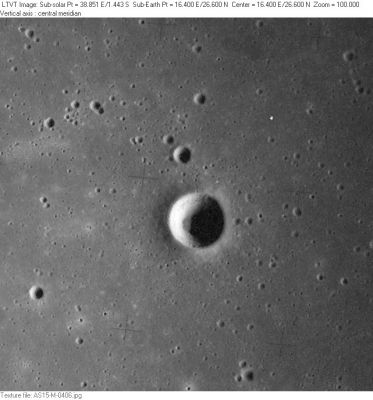Banting
Contents
[hide]Banting
(formerly Linné E)
|
Lat: 26.57°N, Long: 16.42°E, Diam: 5.15 km, Depth: 1.13 km, Rükl: 23 |
Images
LPOD Photo Gallery Lunar Orbiter Images Apollo Images
Maps
(LAC zone 42A3) LAC map Geologic map LM map LTO map
Description
Wikipedia
Additional Information
- IAU page: Banting
- Depth data from Kurt Fisher database
- Westfall, 2000: 1.13 km
- Viscardy, 1985: 1.1 km
- From the length of the shadows in AS15-M-0406, the depth of the crater floor (relative to the east rim) varies from about 1070-1120 m. - Jim Mosher
- Slightly southeast of Banting is a curious craterlet with 270° ejecta blanket around it (located at 25°50' North/ 17°20' East). There's a 90° "corner" of untouched terrain westward of it. This craterlet is described and depicted in NASA SP-362, Apollo Over the Moon, Chapter 5: Craters (Part 2), Figure 112. Detection of the craterlet's exact location: Danny Caes (who calls it the Pacman). See also LROC article Nature's Art.
- To explore the LTO's extreme close-up of the Pacman southeast of Banting, add Longitude 17.35 and Latitude 25.875 in the LRO's ACT-REACT Quick Map.- DannyCaes Aug 20, 2011
Nomenclature
- Named for Sir Frederick Grant Banting (November 14, 1891 – February 21, 1941), a Canadian medical scientist, doctor and Nobel laureate noted as one of the co-discovers of insulin. Banting was widely esteemed in Canada as the first Canadian to achieve worldwide scientific fame. The Canadian government gave him a lifetime grant for his research. In 1934 King George V bestowed a knighthood on him, making him Sir Frederick Banting.
- This replacement name for a formerly lettered crater was introduced on LTO-42A3 (for which it served as the chart title). - Jim Mosher
- Biographical information for the new name appears in Ashbrook, 1974.
LPOD Articles
Bibliography
Named Featues -- Prev: Bancroft -- Next: Barbier
